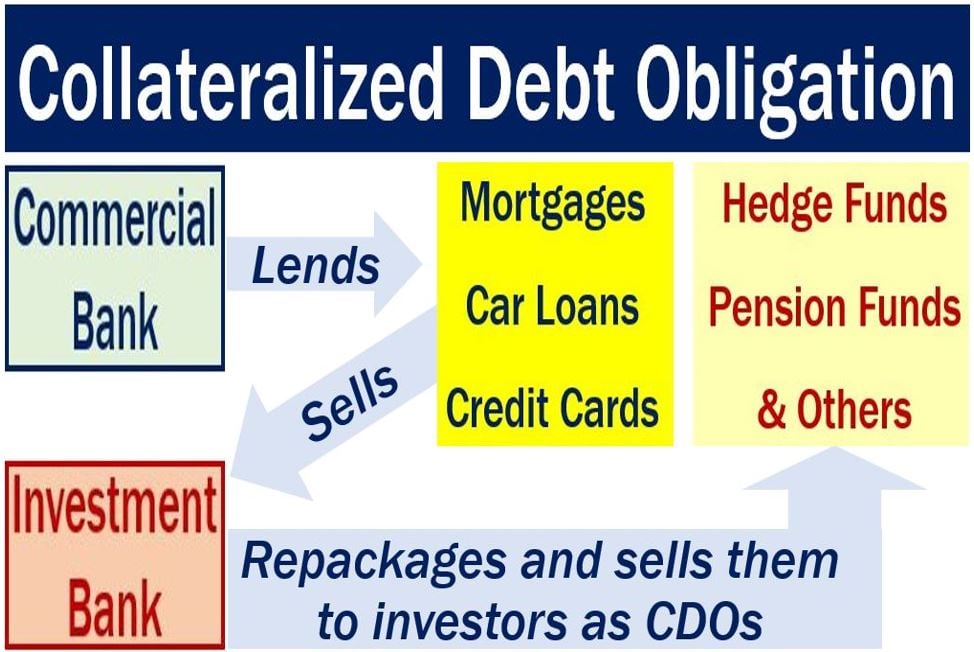Collateralized debt obligation (CDO) – definition and meaning
Collateralized debt obligation (CDO) is a term we use to describe financial instruments that are structured asset-backed securities. A collateralized debt obligation is a financial instrument which a pool of loans backs.
A financial instrument is a monetary contract between different parties which anybody can trade.
When a bank approves a loan, it subsequently sells on that loan to an investment bank. The lending may have been a car loan, mortgage, a credit card loan, etc. The bank may have lent to either a person or a company.
Investment banks then repackage these loans to form investment products. A collateralized debt obligation (CDO) is one of these investment products. Investors then purchase and sell the CDOs.
Banks pass on the interest and principal payments on the loans to the investors in the pool. The collateral that gives the CDO’s value is the promised repayment on the loans in the pool. Hence the term collateralized.
Collateralized debt obligation is a derivative
In other words, CDOs are financial tools that banks use to repackage individual loans. They repackage them into a product and then sell them to investors. This occurs on the secondary market. In fact, a collateralized debt obligation is a type of derivative.
If the package consists of corporate debt, we call the CDO an asset-backed commercial paper. On the other hand, if the loans are mortgages, we call them mortgage-backed securities.
If the underlying loans go bad, banks transfer most of the risk to the investors.
Typical CDO investors are hedge funds or pension funds.

A collateralized debt obligation consists of a portfolio of fixed income securities. We split them into many different ‘tranches’ – one of several related securities that banks offer as part of the same transaction.
The word ‘tranche’ comes from Old French, meaning ‘slice.’
Three types of tranches
We divide the tranches into three different sections, according to the degree of risk the investor takes:
Equity tranches are the riskiest. Hedge fund managers are usually the first to buy them. In other words, hedge fund managers are the first to bear the risk.
Junior tranches are intermediaries. Asset managers or investors buy them.
Senior tranches are the least risky. Rating agencies usually give them an AAA rating. Bond insurers buy them.
A CDO tranche consists of:
- Portfolio of names
- Attachment point
- Detachment point
- Spread contract
- Maturity date
Collateralized debt obligation – structure
Even though a collateralized debt obligation can come in many forms, they all share a similar basic structure.
An SPV (special purpose entity) acquires a portfolio of mortgage-backed securities or high-yield bonds. The SPV subsequently sells bonds to investors.
These bonds entitle the holder to the cash flows from the portfolio of the SPV. The distribution depends on the ranking of the bonds.
Payment from senior tranches occurs before the junior and equity tranches.
The distribution of losses occurs the other way round. In other words, with equity tranches losing first, then junior tranches, and lastly senior tranches.

CDOs and the 2007/8 financial crisis
CDOs are complex and opaque. In fact, their complexity and opaqueness created a market panic in 2007. Banks suddenly realized it was not possible to price the assets or product they were still holding.
From one night to the next, the market for CDOs evaporated. Banks stopped lending to each other. They stopped lending because none of them wanted more CDOs on their balance sheet in return.
TheBalance.com described the situation as a game of musical chairs when the music stopped. In fact, this panic triggered the 2007/8 global financial crisis.
Mortgage-backed securities were the first CDOs to go bad. The price of houses began to fall in 2006. Many homes people bought in 2005 were soon worth less than their mortgages. Subsequently, there was a subprime mortgage crisis.
The US Federal Reserve (Fed) assured investors that the problem was limited to housing. In fact, some people said the decline in house prices was a good thing.
The Fed did not realize how derivatives exacerbate the effect of a bubble and any subsequent downturn.

